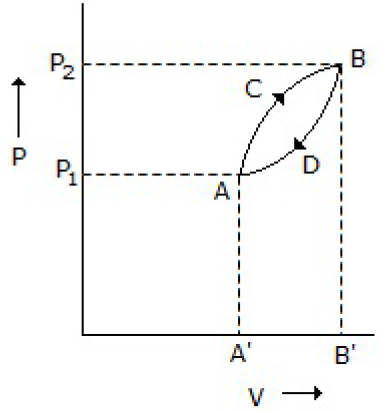Pressure-enthalpy chart is useful in refrigeration. The change in internal energy of an ideal fluid used in ideal refrigeration cycle is
Positive
Negative
Zero
Infinity
Correct Answer :
C. Zero
Related Questions
What is the ratio of adiabatic compressibility to isothermal compressibility?
1
< 1
> 1
>> 1
For a single component two phase mixture, the number of independent variable properties are
Two
One
Zero
Three
Degrees of freedom at triple point will be
0
1
2
3
For an ideal solution, the value of activity co-efficient is
0
1
< 1
> 1
Degree of freedom of a system consisting of a gaseous mixture of H2 and NH3 will be
0
1
2
3
The internal energy of an incompressible fluid depends upon its
Pressure
Temperature
Both (A) & (B)
Neither (A) nor (B)
High __________ is an undesirable property for a good refrigerant.
Specific heat
Latent heat of vaporisation
Viscosity
Specific vapor volume
Which is not a refrigerant?
SO2
NH3
CCl2F2
C2H4Cl2
The rate at which a substance reacts is proportional to its active mass and the rate of a chemical reaction is proportional to the product of active masses of the reacting substances. This is the
Lewis-Randall rule
Statement of Van't Hoff Equation
Le-Chatelier's principle
None of these
Heat evolved/absorbed during conversion of a substance from one allotropic form to another is termed as the heat of
Fusion
Vaporisation
Transition
None of these
The standard state of a gas (at a given temperature) is the state in which fugacity is equal to
Unity
Activity
Both (A) & (B)
Neither (A) nor (B)
Gibbs-Duhem equation
States that n1dμ1 + n2dμ2 + ....njdμj = 0, for a system of definite composition at constant temperature and pressure
Applies only to binary systems
Finds no application in gas-liquid equilibria involved in distillation
None of these
The kinetic energy of gas molecule is zero at
0°C
273°C
100°C
-273°C
Compressibility factor of a gas is
Not a function of its pressure
Not a function of its nature
Not a function of its temperature
Unity, if it follows PV = nRT
The chemical potential of a component (μi) of a phase is the amount by which its capacity for doing all work, barring work of expansion is increased per unit amount of substance added for an infinitesimal addition at constant temperature and pressure. It is given by
(∂E/∂ni)S, v, nj
(∂G/∂ni)T, P, nj = (∂A/∂ni) T, v, nj
(∂H/∂ni)S, P, nj
All (A), (B) and (C)
At constant temperature and pressure, for one mole of a pure substance, the ratio of the free energy to the chemical potential is
Zero
One
Infinity
Negative
Trouton's ratio of __________ liquids is calculated using Kistyakowsky equation.
Polar
Non-polar
Both (A) & (B)
Neither (A) nor (B)
As pressure approaches zero, the ratio of fugacity to pressure (f/P) for a gas approaches
Zero
Unity
Infinity
An indeterminate value
The gas law (PV = RT) is true for an __________ change.
Isothermal
Adiabatic
Both (A) & (B)
Neither (A) nor (B)
Work done may be calculated by the expression ∫ p dA for __________ processes.
Non-flow reversible
Adiabatic
Both (A) and (B)
Neither (A) nor (B)
Cv is given by
(∂E/∂T)V
(∂E/∂V)T
(∂E/∂P)V
(∂V/∂T)P
A thermodynamic system is taken from state A to B along ACB and is brought back to A along BDA as shown below in the P-V diagram. The net work done during the complete cycle is given by the area covered by

P1ACBP2P1
ACBB1A1A
ACBDA
ADBB1A1A
Which one is true for a throttling process?
A gas may have more than one inversion temperatures
The inversion temperature is different for different gases
The inversion temperature is same for all gases
The inversion temperature is the temperature at which Joule-Thomson co-efficient is infinity
Pick out the wrong statement.
The chemical potential of a pure substance depends upon the temperature and pressure
The chemical potential of a component in a system is directly proportional to the escaping tendency of that component
The chemical potential of ith species (μi) in an ideal gas mixture approaches zero as the pressure or mole fraction (xi) tends to be zero at constant temperature
The chemical potential of species 'i' in the mixture (μi) is mathematically represented as,μi = ∂(nG)/∂ni]T,P,nj where, n, ni and nj respectively denote the total number of moles, moles of ith species and all mole numbers except ith species. 'G' is Gibbs molar free energy
Joule-Thomson Co-efficient at any point on the inversion curve is
∞
+ve
0
-ve
Entropy of a substance remains constant during a/an __________ change.
Reversible isothermal
Irreversible isothermal
Reversible adiabatic
None of these
For an irreversible process involving only pressure-volume work
(dF)T, p <0
(dF)T, p = 0
(dF)T, p > 0
(dA)T, v >0
Lowering of condenser temperature (keeping the evaporator temperature constant) in case of vapour compression refrigeration system results in
Increased COP
Same COP
Decreased COP
Increased or decreased COP; depending upon the type of refrigerant
The first law of thermodynamics is a restatement of the law of conservation of
Mass
Energy
Momentum
None of these
With increase in compression ratio, the efficiency of the otto engine
Increases
Decreases
Remain constant
Increases linearly
